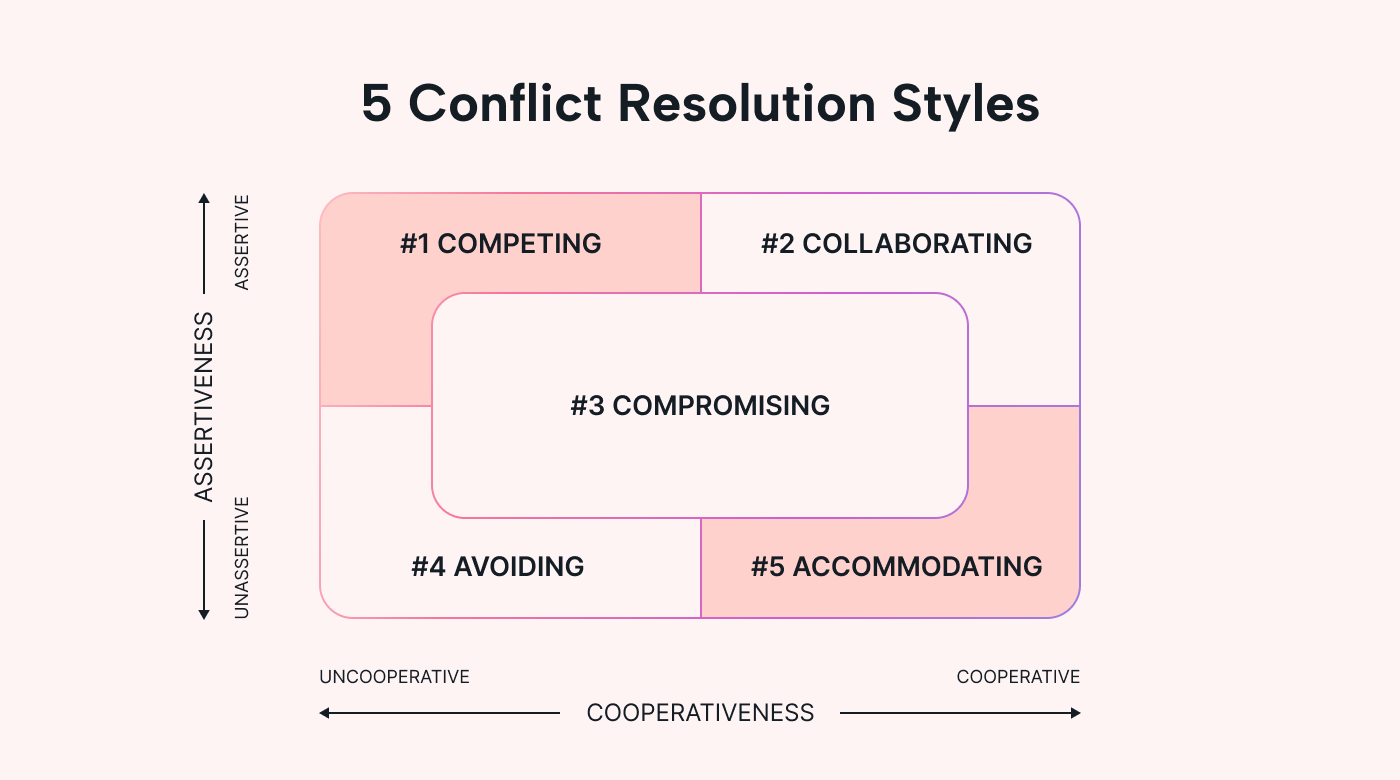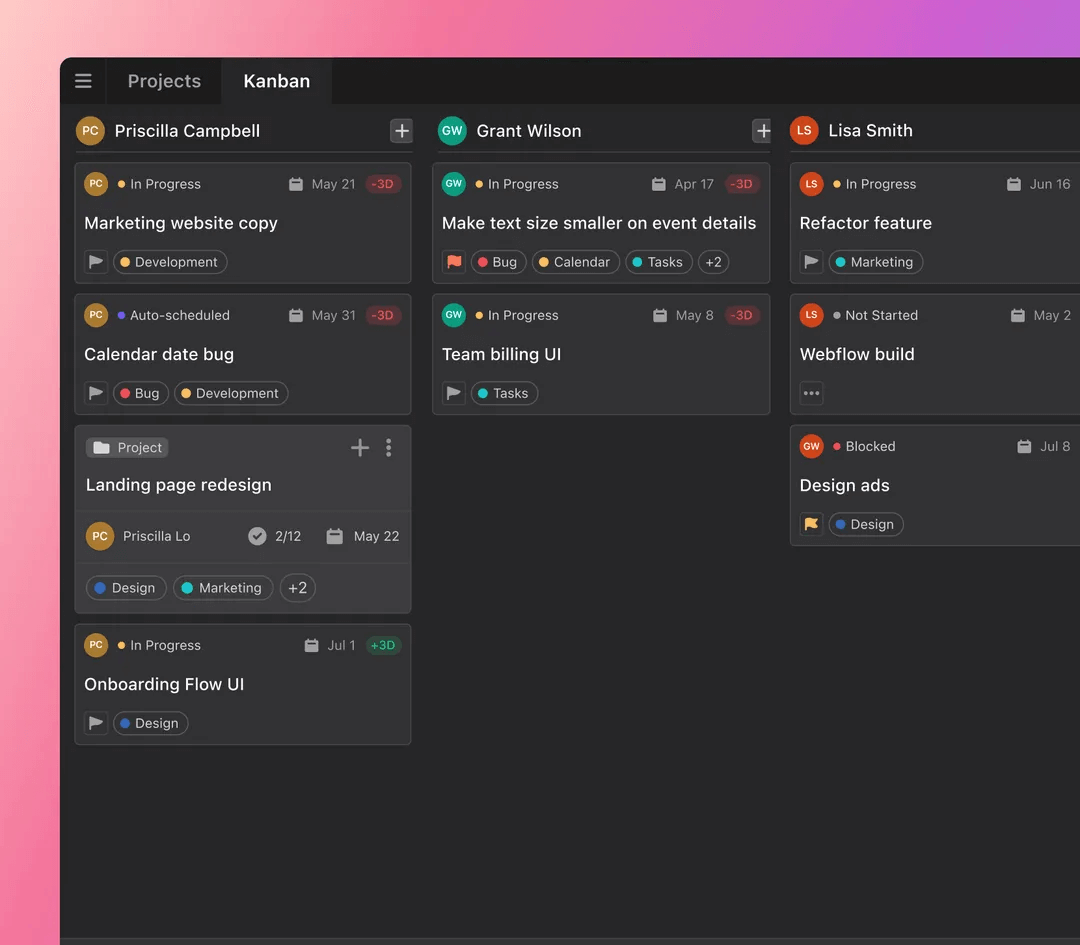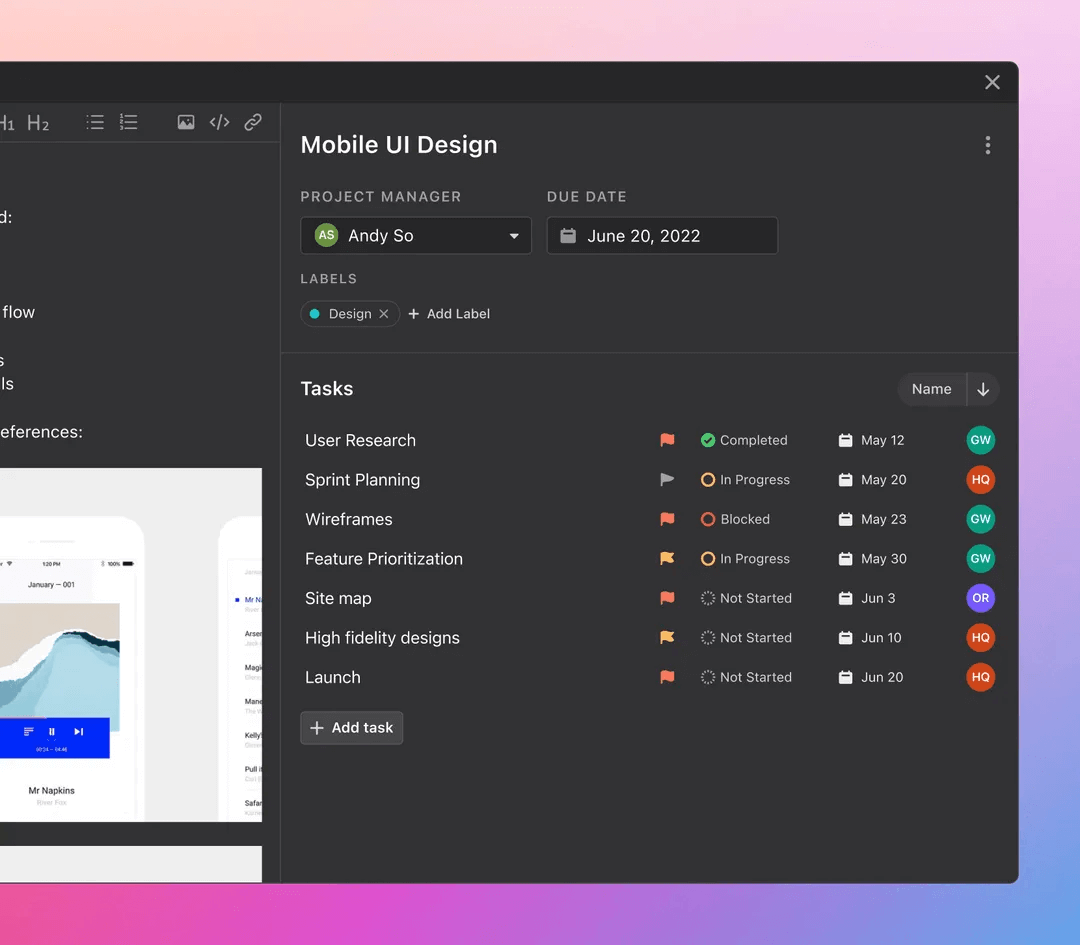Ah, workplace conflict — that unwanted guest who always manages to barge in and disrupt office harmony.
Conflict can cause tension, communication breakdowns, as well as reduced productivity, profitability, and morale among team members.
But with the right approach, conflict can actually be a catalyst for growth and positive change. You just have to know how to resolve it.
Conflict resolution is an essential skill for fostering effective communication, meaningful collaboration, and a thriving work environment.
In this article, we’ll dive deep into the world of conflict resolution, exploring the benefits, styles, and practical strategies you can put into action. So grab a cup of coffee and get ready to discover the secrets to maintaining peace and productivity in the workplace.
What is conflict resolution?
Imagine a scenario in which two colleagues have differing opinions on how to approach a project. Neither will back off, which causes tension and hinders progress. What should you, as a manager, do?
You have to resolve the situation before it escalates or damages morale. And understandably, you might not know where to start or how to step in and iron out the tension, frustration, and other negative emotions.
That’s where conflict resolution strategies come into play. They give you a roadmap to a solution.
Conflict resolution is the process of finding a mutually acceptable solution to a disagreement so the parties involved can agree on a way forward.
It involves effective communication, active listening, and problem-solving techniques, and with it, you can guide your team toward a win-win resolution.
But before you know what type of conflict resolution strategy to use, you should know what’s behind the conflict.
What causes workplace conflicts?
Workplace conflict is inevitable, even in high-functioning offices. When you have employees with different backgrounds and working styles, disagreements are bound to happen.
Differences often drive disagreements. And disagreements tend to escalate into conflicts when a breakdown in communication happens. In fact, poor communication causes conflict 56% of the time.
Let’s take a look at four common causes of workplace conflict:
- Conflicting priorities: When team members have contrasting goals or competing objectives, conflicts can arise as each tries to prioritize their own agenda.
- Conflicting perspectives: Different viewpoints on how to approach tasks, projects, or problems can lead to problems when each person believes their perspective is the “right” one.
- Conflicting assumptions: Misinterpreting others’ intentions and assuming that everyone sees things in the same way is a major cause of conflict in the workplace.
- Conflicting tolerances: People have different levels of tolerance for factors like risk, ambiguity, and change. When these thresholds clash, conflict can happen as individuals retreat to their comfort zones.
Benefits of effective conflict resolution at work
Although the idea of experiencing conflict at work can sound intimidating, effective conflict resolution skills can inspire positive outcomes and strengthen teams.
“Successful leaders manage conflict; they don’t shy away from it or suppress it but see it as an engine of creativity and innovation,” said Ronald Heifetz and Marty Linsky, the authors of The Practice of Adaptive Leadership. “The challenge for leaders is to develop structures and processes in which such conflicts can be orchestrated productively.”
As you learn how to master conflict resolution, here’s what you’ll be able to do:
Build strong teams
According to NABS, a charity organization that provides support and guidance for businesses, conflict in the workplace is the third-biggest reason employees contact them for support. Conflict within teams can disrupt workflow, hinder collaboration, and foster a negative work environment.
 |
Resolving conflicts improves team unity and trust, which can help you overcome obstacles and differences. Successful conflict resolution fosters strong team dynamics and cultivates a positive work environment in which individuals feel heard, respected, and valued.
Achieve common goals
Did you know that 36% of people deal with conflict very often at work?
Disagreements take up a significant amount of time and effort, chipping away at the time available to do meaningful work.
Conflict resolution helps teams achieve goals more efficiently by minimizing productivity disruptions caused by unresolved conflicts.
Gain new insights
Conflict resolution helps you gain valuable insights by understanding the other person’s perspective.
New insights can foster innovation, facilitate learning, and promote personal and professional growth. Embracing different viewpoints and engaging in constructive dialogue expands your team’s knowledge, leading to continuous improvement and development.
Improve retention
Conflict is expensive. In fact, UK employers lose an average of £28.5 billion and 485,800 employees per year due to workplace conflict.
Resolving conflicts shows your commitment to fulfilling your employees’ needs and ensuring a supportive work environment. That improves employee satisfaction and engagement, which will reduce turnover.
5 conflict resolution styles
Now for the important question: how can you effectively resolve conflicts and reap the benefits mentioned above?
 |
It all starts with deciding what conflict resolution approach to take. Here are five different conflict resolution styles that you can use. We’ll discuss each of them in detail below.
1. Competing
The competing style focuses on individual needs and goals, often resulting in a win-lose outcome.
This approach can be useful when standing up for your rights or when quick decision-making is necessary, such as in an emergency. The assertiveness required can help you achieve the desired outcomes promptly, but it may not be best for long-term collaboration.
2. Collaborating
The collaborating style values open communication, active listening, and finding mutually beneficial solutions through cooperation and teamwork.
It works well for complex problems and team projects that would benefit from multiple perspectives and mutual trust. Actively listening and collaborating helps your team harness their knowledge to solve problems and foster shared ownership.
3. Compromising
In the compromising conflict resolution style, the parties look for a middle ground to find a solution that partially satisfies both of them.
 |
When time is limited and you need a quick answer, compromising can be a useful tactic. As a manager, if you want to maintain a level of fairness, you can also encourage both parties to compromise.
4. Avoiding
The avoiding conflict resolution style is when the individuals involved choose to ignore or evade the conflict. This style often results in unresolved issues and lingering tension, which can strain relationships.
However, the avoiding type can be an effective strategy during a heated argument when one or two parties need to cool off before having a discussion. Initially avoiding the conflict can diffuse emotional intensity and allow you to return to the conversation more level-headed.
The avoiding conflict resolution style can also be used when the disagreement is very trivial and not worth escalating into a bigger conflict.
5. Accommodating
Accommodating happens when the parties involved in the conflict prioritize maintaining harmony and the other party’s needs before their own.
When the parties’ long-term relationship is more valuable than the conflict’s immediate outcome, adopting an accommodating approach can help preserve goodwill and foster positive rapport. However, relying too heavily on accommodation can result in personal dissatisfaction or an imbalanced power dynamic over time.
A step-by-step guide to resolving workplace conflict
Conflict resolution isn’t an easy feat. On average, managers spend four hours a week dealing with workplace conflict, yet one in four employees think their managers handle conflict poorly.
As a manager, it’s your duty to make sure the conflict resolution process runs smoothly. Follow this step-by-step guide to resolve your workplace conflicts like a seasoned mediator:
1. Acknowledge the conflict
The first step is to acknowledge the conflict by openly recognizing its existence and impact on the individuals involved and the work environment at large.
Instead of ignoring the conflict or pretending it doesn’t exist, you validate your employees’ experiences and concerns. This step sets the foundation for addressing the issue and demonstrates to your team that their problems are important.
2. Involve both parties
According to Acas, 1 in 5 employees do nothing when faced with a conflict they’re involved in. This passive approach only prolongs the conflict and hinders its resolution.
Encourage active participation, and inspire your employees to face their problems head-on so that they’re addressed directly and promptly. This will increase the chances of reaching effective resolutions.
3. Identify the problem’s root cause
After involving all the parties concerned, dig deeper into the underlying issues and understand the core factors that contributed to the conflict. This requires thorough investigation, including discussions with the involved individuals and gathering insights from others who may have valuable perspectives.
After you understand the root cause, you can address the underlying issues with targeted solutions that have a lasting impact.
4. Facilitate open and respectful communication
Having open and respectful communication may be the most challenging step, but it’s also very important. It requires the creation of a safe and supportive environment in which team members feel comfortable expressing themselves and engaging in constructive dialogue.
During this time, it’s important to avoid making assumptions, jumping to conclusions, or dismissing someone’s experience. Instead, actively listen, try to understand different perspectives, and validate each person’s feelings and viewpoints.
 |
Promoting open and respectful communication addresses the core of most workplace conflicts and empowers your employees to resolve disputes in a fair and empathetic way.
5. Explore collaborative solutions
Explore collaborative solutions by bringing together the insights and understanding you gained during the previous steps.
All the groundwork will pay off, as you’ll get to leverage your team’s diverse perspectives and collective knowledge to generate creative ideas and innovative solutions.
Collaborative exploration and brainstorming let you build an environment where team members strive to find mutually beneficial resolutions.
6. Follow up on the conflict
Remember to follow up to ensure that the agreed-upon solutions are implemented and effective. Prioritize offering ongoing support, and make any necessary adjustments to keep the solutions effective.
This last step will demonstrate your commitment to the resolution process and your team’s well-being, fostering a culture of accountability and continuous improvement within the workplace.
5 conflict resolution strategies to practice in the workplace
We’ve compiled a list of five effective conflict resolution strategies that emphasize effective communication and collaboration to help you make a real difference at work. Let’s take a look.
1. The open-door policy
Some employees may be reluctant to confide in their superiors, especially if they find them unapproachable or disengaged.
As we learned above, good communication is key to resolving workplace conflicts, so it’s essential to make your employees feel safe and supported in communicating their problems.
Establish an open-door policy to encourage your employees to discuss conflicts, seek guidance, and find resolutions together. Demonstrating your approachability and receptiveness will help you create a culture of open communication.
You can use digital tools like Motion to make communication more accessible and efficient between you and your employees. Motion provides direct messaging and commenting channels that promote easy and open communication whenever and wherever.
2. Practice active listening
What’s the difference between listening and active listening?
Well, while listening is the basic act of receiving information, active listening is a more involved process that requires attentiveness, understanding, and active engagement with the speaker.
Active listening makes people feel valued and understood — ultimately leading to a supportive, empathetic, less defensive environment.
Whenever a conflict comes up, offer undivided attention to those involved. You can show this by empathizing, asking clarifying questions, acknowledging each party’s perspectives, and validating their experience.
3. Offer constructive criticism
When addressing conflicts, focus on providing feedback that’s specific, objective, and solution-oriented. Instead of shifting blame or making personal attacks, provide constructive criticism that helps the individual grow.
Teams that receive constructive criticism are less likely to take criticism negatively, as they understand that the intention behind it is to support their growth and improvement.
Motion’s real-time progress tracker enables teams to stay on top of individual projects and tasks. This transparency makes it easier to offer evidence-based feedback and constructive criticism so that team members can separate their work from their personal feelings.
4. Offer guidance, not solutions
When it comes to resolving conflicts, it’s important to be a guide rather than a problem solver. Instead of handing out ready-made solutions, empower your employees to identify and find their own resolutions.
This process not only promotes personal growth and problem-solving skills but also sparks a sense of ownership and confidence in your team.
As you encourage your employees to think critically and creatively, you also build a learning environment in which everyone can tackle their challenges head-on.
5. Promote collaboration
Collaboration is the not-so-secret secret ingredient that turns challenges into wins, even when the going gets tough. So, when a difficult situation arises, inspire your employees to work together to find common ground, brainstorm solutions, and engage in shared decision-making processes.
You can use Motion to manage projects, set schedules, and automatically prioritize and delegate tasks to teams — all of which can simplify the collaboration process.
Motion’s team calendar also boosts collaboration by consolidating important dates, tasks, deadlines, and milestones in one place. Motion’s intuitive features will help your team stay organized, informed, and aligned toward achieving shared goals.
How Motion helps your team resolve conflicts
We know conflicts are an unavoidable workplace challenge. But fear not — we can help!
Our intelligent calendar keeps track of important dates, deadlines, and milestones so that everyone on your team stays organized and aligned. Automated task delegation and prioritization streamline workflow, reducing the chances of conflicts caused by miscommunication or task overload.
The ability to track project progress in real time also keeps everyone accountable and on track. Direct communication channels enable team members to share updates and discuss and resolve any issues that arise.
With Motion, conflict resolution becomes a rewarding and collaborative process for your team.








